What do you and weight training have in common? Well, other than cold iron and yourself; how about constant irritating achy shoulders? Yes, achy shoulders. The shoulder joint is the main fulcrum in all upper body movements. So, if you want to accomplish your goals in the gym you cannot afford to have shoulder problems.
Achy shoulders mainly happen because of improper lifting technique, changing your exercise routine to often, or overloading and pushing to much weight in an exercise. One of the most common problems, to occur with the weight trainer, when performing weightlifting exercises, is shoulder impingement. These types of shoulder injuries are reoccurring, and take a very long time to heal.
Impingements can hinder your ability to perform most pressing movements. There are many different forms of impingements. The most common is the Subacromial impingement; known more as "Bursitis" and it is a common condition of the shoulder. A shoulder impingement also gives an uncomfortable achy feeling just from sitting and lying down. An impingement occurs when compression over the shoulder joint is against the surrounding anatomic structures. Anatomically correct, the affected area is the gleno-humeral joint and supraspinatus. The anterior acromion and cora-coacromial ligaments are the most common sites inflamed. An impingement could also be due to incorrect exercise technique or weak rotator cuff muscles. A rotator cuff strain, with all it's swelling, causes what is called mechanical impingement. This type of impingement is the pinching of the tissues described above between the humeral head and the acromion. Shoulder pain could transpire from a pinched nerve, which occurs between the neck and shoulder blade area.
Exercise Review
Since we are discussing shoulder problems that arise from exercising, let's take a look at some of the most common exercises that can have potential for shoulder adversity. The first is the military press, which is performed behind the neck or to the front. Dumbbell presses, and side lateral raises are basic shoulder exercises that can create a shoulder impingement too. As you know, most of these exercises can be performed standing or seated, with free weights or with machines. The bench press is a very common shoulder impingement maker. A grip to far outside the shoulders places tremendous stress on the anterior deltoid. One other exercise, that causes shoulder injuries, is the back squat. Yes! That's right I said squats. The bar is placed behind the shoulder girdle and lays on top the trapezoids, or lower in-between the shoulder blades and traps if you're a powerlifter type. By performing the above exercises with too much weight and/or incorrect technique usually leads to impingements.
Testing: One-Two-Three
Let's survey a few of these shoulder exercises and describe correct lifting technique for them. Now, the most common shoulder exercise performed in-correctly is the side lateral raise. Side lateral raises, to do them right, need to be done step by step. So, stand with a pair of very light dumbbells at your sides, now turn your thumbs slightly down, maybe a half-an-inch and then bend your elbows 35 degrees tops - this alignment ensures that the resistance is placed directly to the side delts. Now, without changing the position you are in, raise the dumbbells. You should resemble a huge letter "T." The dumbbells and elbows should not elevate over or under your shoulders. So, if you are one of those individuals that raises the dumbbells over your head, resembling a bird trying to take off, then it's time to call in the Undercover Gym Police and ticket you for erroneous procedures! Either that, or we will have to give you clearance for take-off.
The next shoulder exercise is military presses and dumbbell presses. These exercises are designed to hit all three deltoid heads. Both movements are best to be performed seated. Why? Well, first of all this prevents you from cheating. You have to focus on pressing the bar or dumbbells upward, working the deltoids. The execution of a rep should be smooth and controlled.
Remember, I mentioned that bench press and squats could also be at fault for shoulder problems. Most of us link a pectoral tear with bench presses not a shoulder impingement or rotator cuff injury. But, the latter is more common to occur from bench press and squats.
Dealing With The Pain
First, like we discussed earlier, watch your form on all upper-body exercises. You can become injured very fast if the exercise itself is not performed properly. Being in the correct anatomical position, and the correct lifting angles doesn't give injury a chance to occur. I always see individuals jerking weights up and down, relying mostly on momentum, and forcing their shoulders out of alignment all the time.
After an impingement injury has been identified, rehab treatment should be performed. Treatment consists of the following techniques: If any discomfort is noticed while performing an exercise then it should be avoided for a couple weeks. Rest the area, and apply ice twenty minutes a day. If you don't know it yet, ICE is the miracle cure-all for injuries. But, there are those few who do rehab with heat. I would still apply ice to the shoulder first just to reduce any possible swelling in that area. But, if you insist upon pushing through your training then apply an ice pack after each workout to your shoulder.
Dr. Pete Gratali, from ESPN's Body Shaping, instructs to perform internal and external rotations on a low cable pulley for 30 to 50 repetitions with 5 to 10 pounds prior to starting ALL your upper body exercise programs. "It is good practice to perform internal and external rotation exercises prior to each and every upper body workout, even if you are not experiencing an impingement problem, the exercises are great for warming up the whole shoulder girdle." Explains Dr. Pete. You can also perform these simple exercises with 5 or 10 pound dumbbells. Internal and external rotation exercises are simple rehab and warm up exercises to help you get around in the gym better.
You should always see a chiropractor or doctor when a shoulder injury occurs, and make sure you consult a certified physical therapist for the correct technique for all rehab exercises. I had the chance to work along-side athletic trainers and school team physicians when I worked as an assistant collegiate strength coach. This education and knowledge has allowed me to insure proper technique for rehab exercises. We have examined shoulder problems, exercise technique, and rehab recommendations giving you a better nucleus on your shoulder training. So, do not become injured from executing wrong exercise technique. You must train shoulders smart.
We all use the same exercises for shoulder development. You know, the basics, bar presses, dumbbell presses and side-laterals. These exercises all work great for size, but what about overall development, shape, and roundness of the shoulders? The shoulders are small muscles involved in almost every movement that a bodybuilder performs. They are an important component when training chest, back, biceps, and they even get stretched when performing squatting movements. There are three heads to training the delt muscles. The front or anterior, the medial or most commonly called the lateral, and the rear or posterior deltoid head. A shoulder workout is one of the most important all-around developers and should consist of a three-prong approach. When performing any of these unknown shoulder exercises or any combination of, will pound the entire shoulder girdle into submission, so I highly recommend you train shoulders by themselves.
Shoulders fatigue quickly when applying continuous tension. Keeping shoulder muscles in constant contraction throughout these exercises provides an extreme intense shoulder burn that will promote strength. This can be brought on through the use of cables, and machines as well as barbells and dumbbells. Then how do we develop overall shape? Variations from the standard movements will do the job very well. Most of these movements are not particularly common in the gym. I guess that's why they're unknown.
8 Shoulder Exercises
The following are 10 unknown shoulder exercises that allow one to stress the anterior, medial and rear deltoid heads with a little extra-added jump on the traps just because of their unique movements. Use any of the following unknown shoulder exercises in your program and they will stimulate them for optimal development. These 10 exercises are plate raises, single dumbbell raises, cable front raise with rope, incline front raises, bent-over front raise, lying front raise, cable side-lateral raise w/ rope, side- lateral w/ a bar, lying reverse cable fly's, and bent over laterals.
EXERCISE 1 Plate Raises
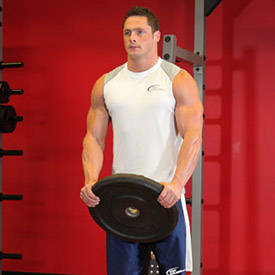
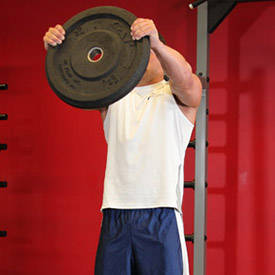
These are my favorites. Start with an Olympic plate, preferably a 45 pounder. But, if you are a novice and your shoulder strength is not developed to it's fullest then I would start with a 25-pound plate. I've personally worked up to a 100-pound plate for three sets of 8 and when pushing this amount of weight the movement can become very intense. Place your hands around the middle of the plate. Perform three sets of 8. There are variations of this movement that can make it harder too. How? Changing your handgrip for one. By placing your hands more toward the top of the plate makes it a lot harder to raise. This movement is a similarity to the single dumbbell front raise.
EXERCISE 2 Front Dumbbell Raise
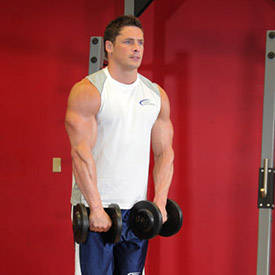
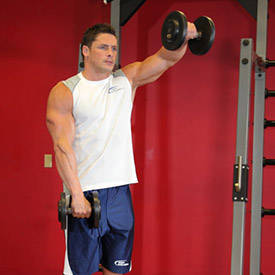
Instead of using a plate or two dumbbells for front raises, you only use one. That was simple. Not so simple when you start on this shoulder crunching exercise. Grip a single dumbbell by placing your hands around the dumbbell. Then raise the dumbbell to eyes length and your arms are parallel to the floor. When the lift becomes difficult, bend your elbows ever so slightly to get extra repetitions. But, don't rock back and forth like a push- me-pull-me. If you prefer these to plate raises then do three sets of 10-12 repetitions progressively moving up 5 or 10 pound increments.
EXERCISE 3 Front Cable Raise
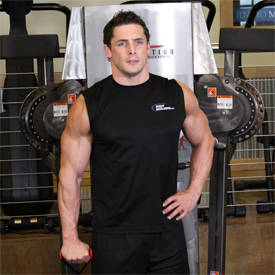
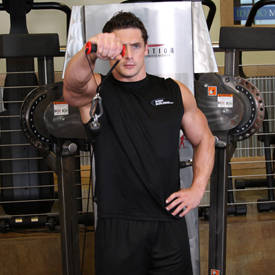
Grasp a rope handle and attach to a low pulley and then straddle the cable facing away from the stack. Start with your fists touching groin level and then slowly raise your arms until your fists are eye level and your arms are parallel with the floor. Avoid jerking the rope and swaying your body just to get the weight up when your muscle start to fail. Keep your body in an upright position throughout the full range of motion. Begin with a set of 20 reps and then two more for 15 each adding weight to each set.
EXERCISE 4 Front Incline Dumbbell Raise
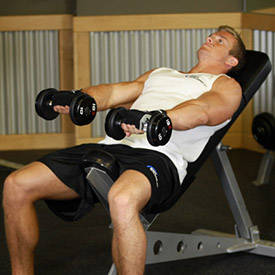
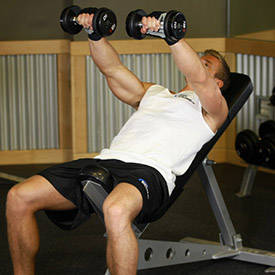
For variation, you can use a light barbell instead of dumbbells. Your hand spacing can be different and varied, anywhere from shoulder width to six to eight inches apart. On a 45- degree incline bench. With anterior delt movements such as these avoid cheating the weight upward. Always move the dumbbells or bar in a slow and controlled manner.
EXERCISE 5 Bent over two-dumbbell Row

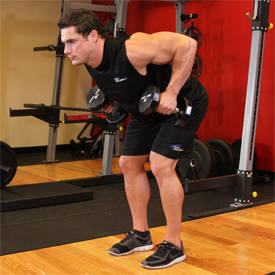
This is not a particularly common shoulder exercise. This movement strongly stresses the anterior and medial heads of the deltoid. Because of body position, the trapezius and upper back muscles also receive a significant amount of stress. Grasp two dumbbells, flex your knees, arch your lower back for support, and then bend at the waist until your torso is almost parallel with the floor. Hang your arms straight down towards the floor. Slowly move your arms to the front above the plane of your head or at eye level. Choose dumbbells light enough to complete four sets of 10 reps. A variation of this movement places you on a bench.
EXERCISE 6 Reverse Flyes
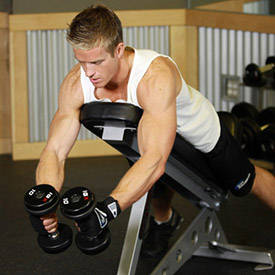
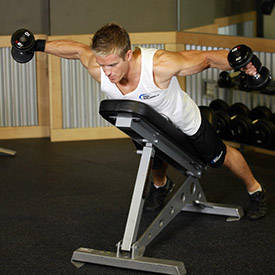
This movement is a slight variation of the bent-over front raise. But, with this variation you don't have the luxury of cheating. Lie down face down on a bench, try and get a high bench, making sure your head and shoulders are over the end of the bench. Grasp a pair of really light dumbbells. The dumbbells should hang down towards the floor with a palm down grip. Slowly lift the dumbbells upward until they are parallel with the floor. After squeezing your delts for a second, slowly lower the dumbbells back down controlling them back to the starting position. If you wish to get a few extra reps without cheating then have a partner assist you. Having them kneel in front of you, and have them raise the dumbbells slowly does this. Do four sets of 12 repetitions.
When performed correctly, side laterals attack the medial or side-head portion of the deltoid perfectly. Most believe you should bend the elbows slightly during the movement, but this is not totally correct for just a slight bend in the elbows can off-set the stress off of the delt. Most commonly you see individuals almost doing "front raises" when trying to perform side-lateral movements. Bending the elbows has the tendency to bring the dumbbells forward, which stresses the already overdeveloped anterior or front delt. Also, if you raise the arm too high you stress the traps. So, that is why we'll do these specific exercises for side-head deltoid training.
EXERCISE 7 Side Lateral Raise
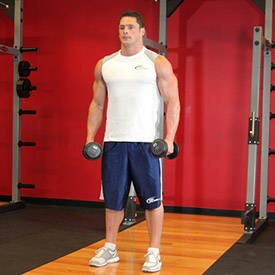
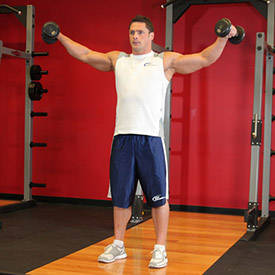
So, let's begin by setting you up in front of a cable cross over machine and place a rope on each side weight stack. Grasp the rope in each hand, raise slowly with your thumbs up keeping your arms straight out to your sides. Avoid jerking the rope and swaying your body just to get the weight up. Keep your body in an upright position throughout the full range of motion. Perform 4 sets of 12 reps. Remember keep your arms straight, no elbow bend.
EXERCISE 8 Cable Seated Lateral Raise
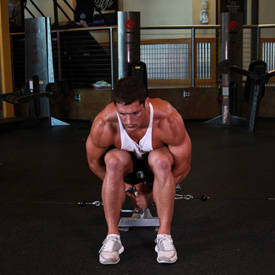
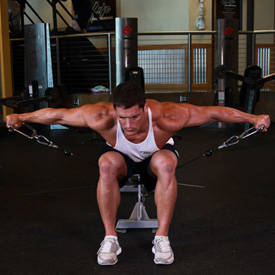
This movement develops the posterior head of the delt, which gives the complete round deltoid look. Sit backwards on an incline chair lowered almost all the way down. Hold the lower kettle handles of a cross cable machine downward arms held down with elbows bowed outward. Raise the cable upward and outward was high as possible and bring slightly forward, squeezing the rear deltoid. Return to the staring position and repeat. If you need to, lean your chest forward on the bench for support. Try 3-4 sets, 8-12 repetitions.
Give Your Shoulders Time to Recover
By the end of this routine your shoulders should be so pumped and wasted that combing your hair is out of the question. As it should be with all your body parts shoulder training should be done once a week. Training like this gives your muscles, tendons, and ligaments lots of time to recover and repair themselves. All the assorted back training movements can easily over train this same lobe. So, to make this deltoid muscle a factor in your training try rear delts on back training day. This is especially needed, as the shoulder is the focal for all upper body movements. Work these POWER Blast shoulder secrets exactly in this order, hard, and watch them air up like balloons. Oh yeah, remember to give me one more rep!
References
- "Shoulder Injuries, Impingement Syndrome & Rotator Cuff Tears." By William R. Gallivan, Jr., MD.
- "Shoulder Rehabilitation, Parts I, II, III" By Thomas Souza, DC, DACBSP. DC Archives.
